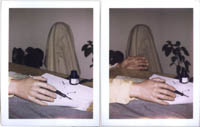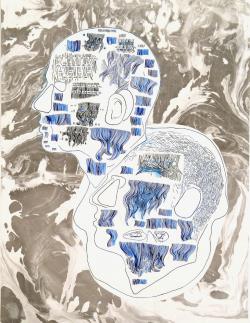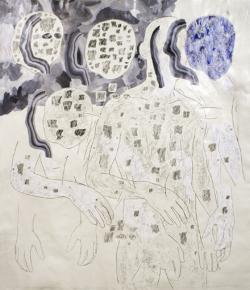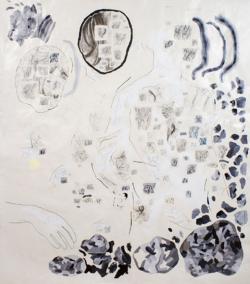
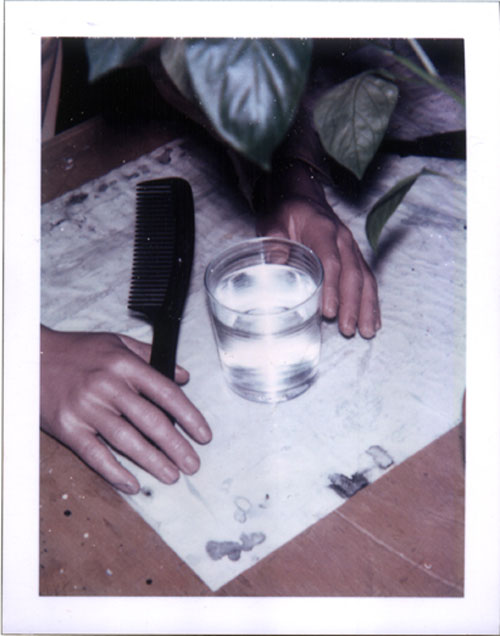
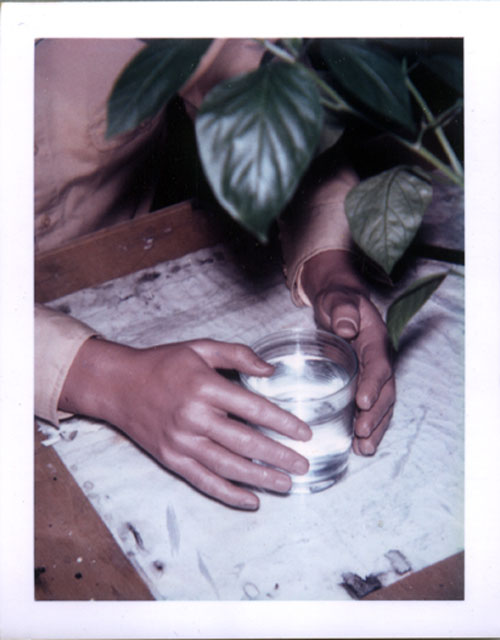
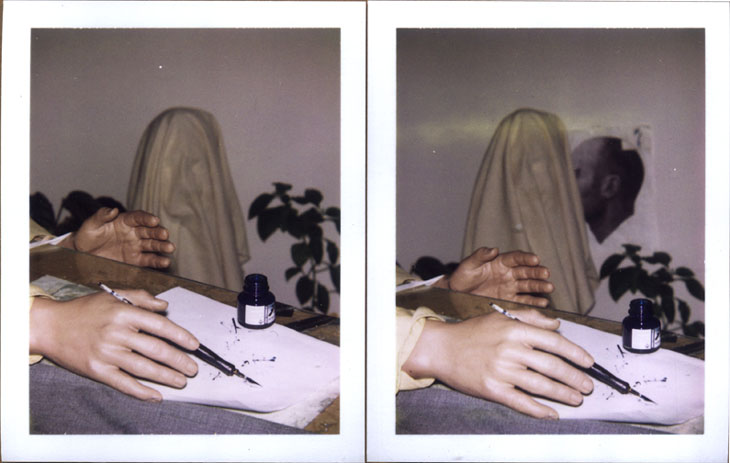
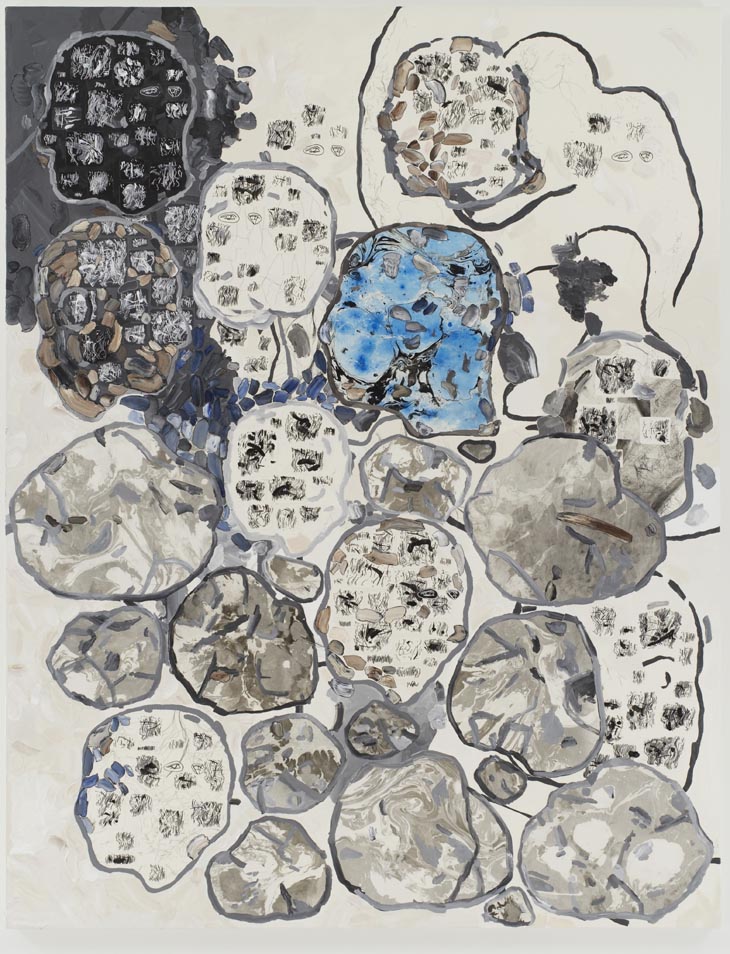
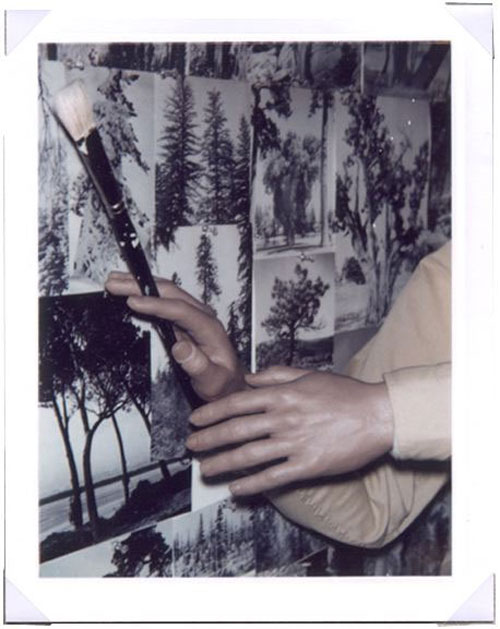
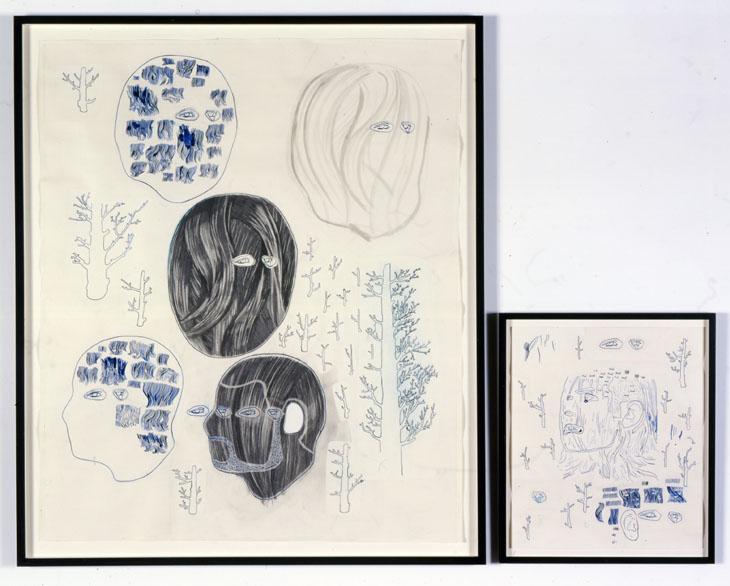


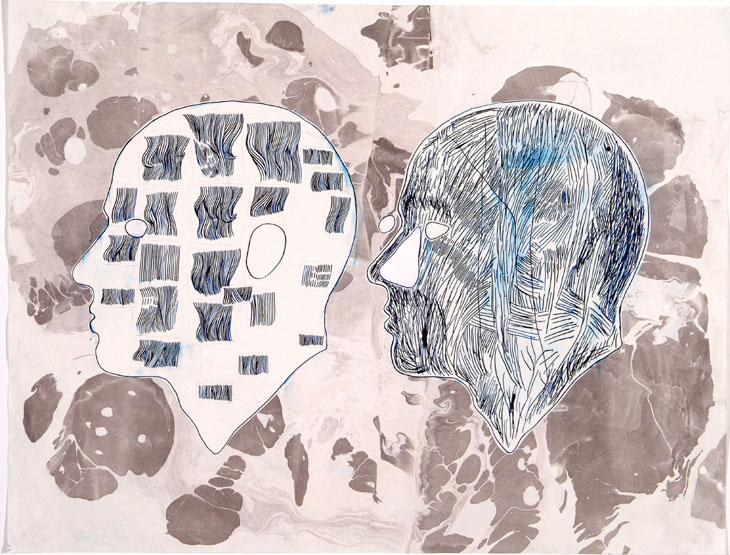

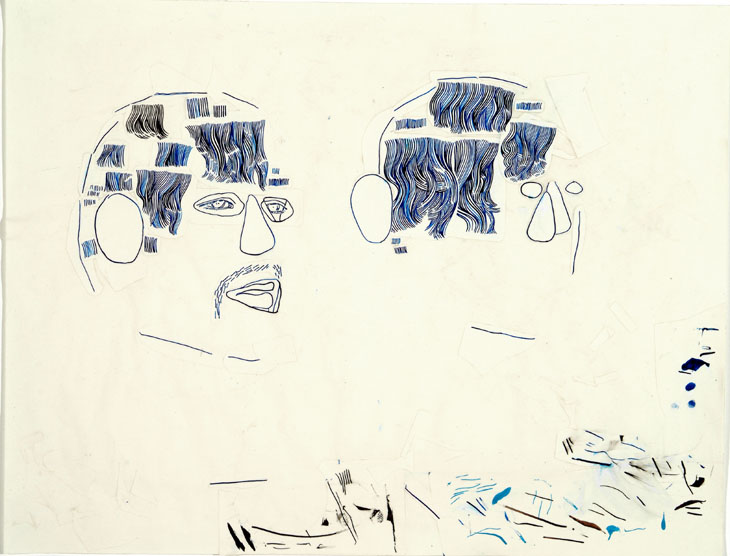
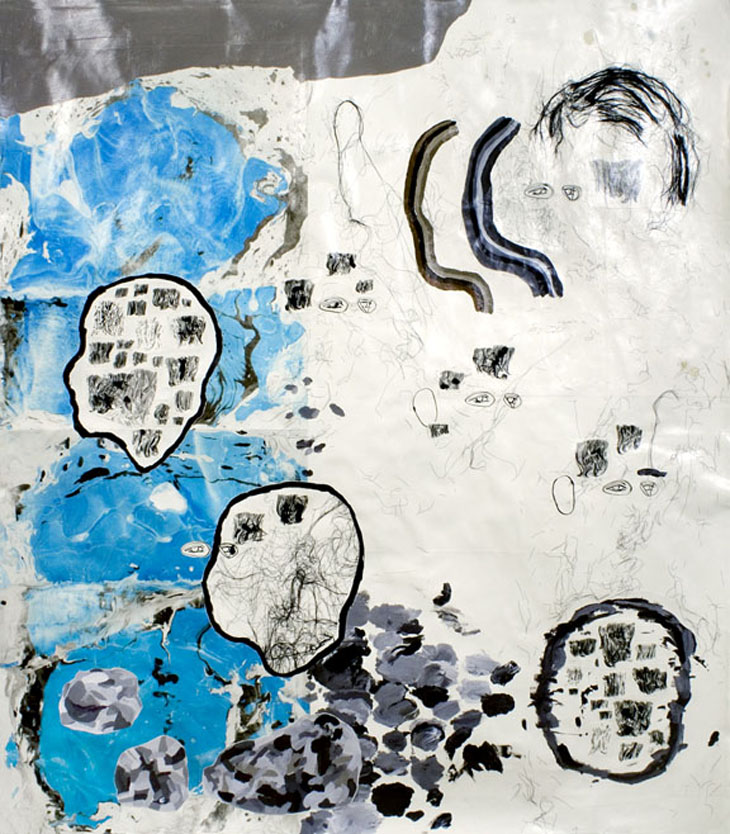
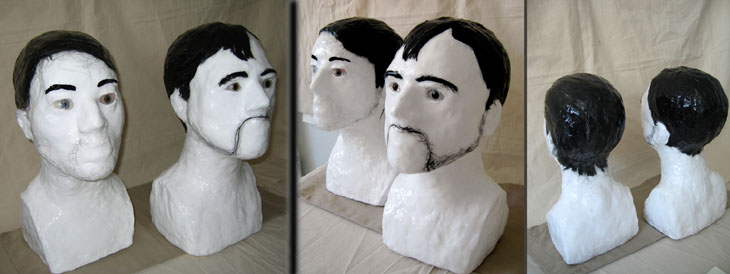
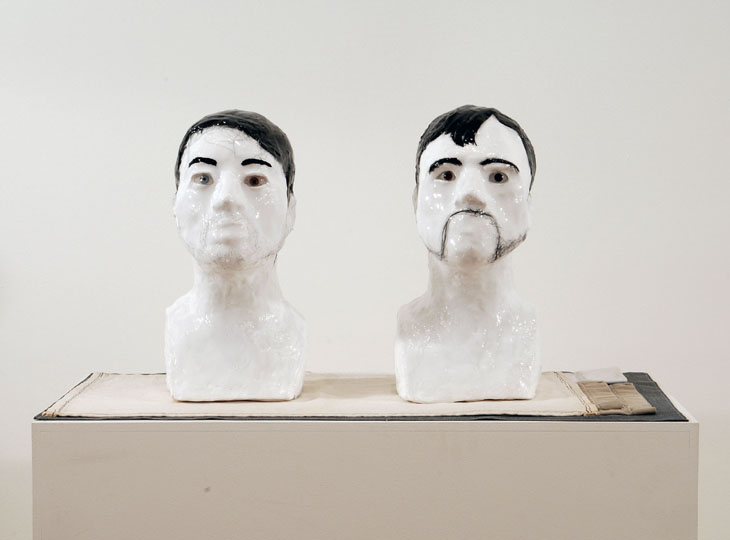
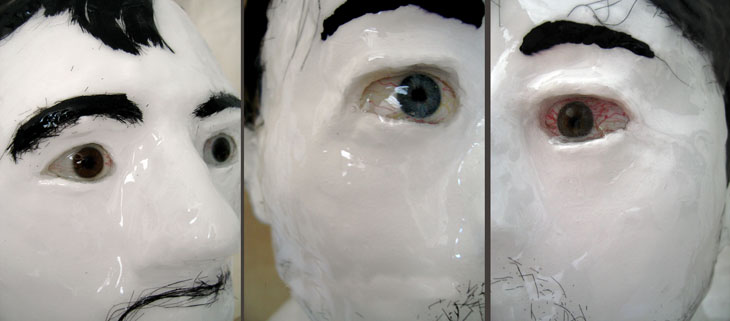


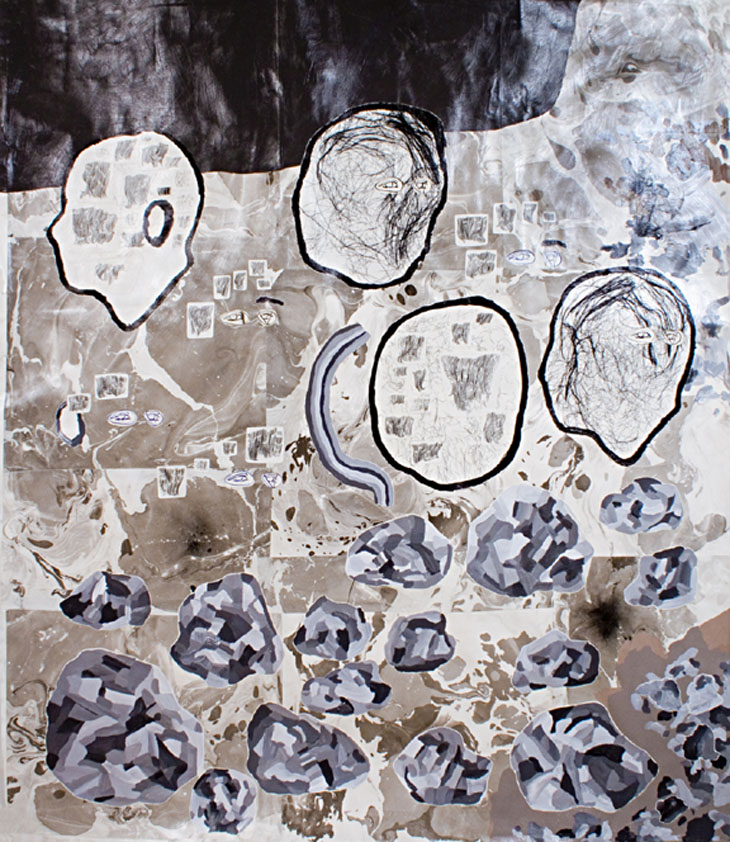
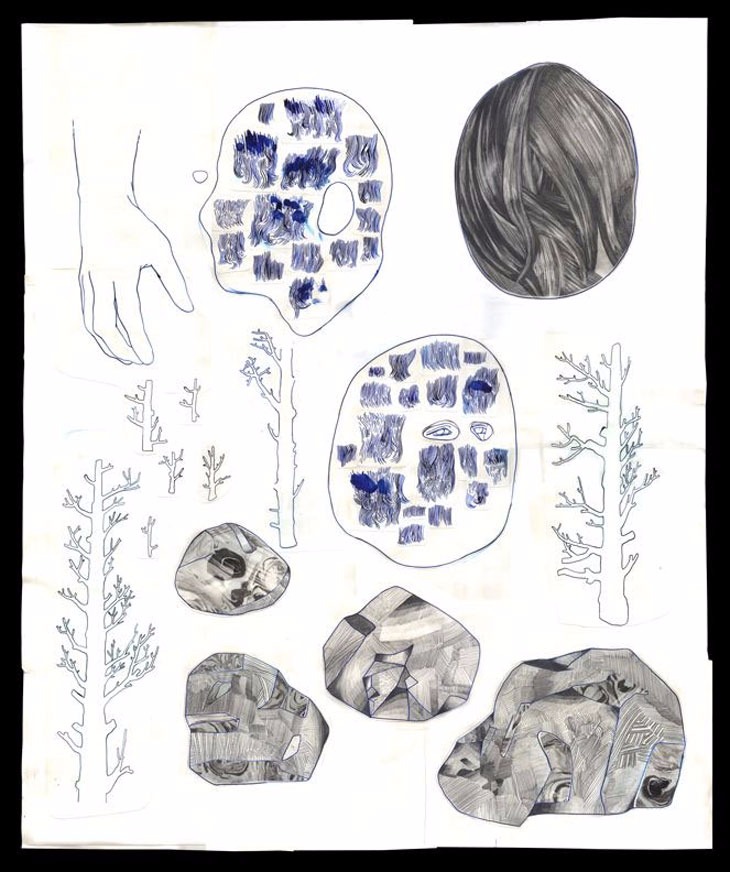

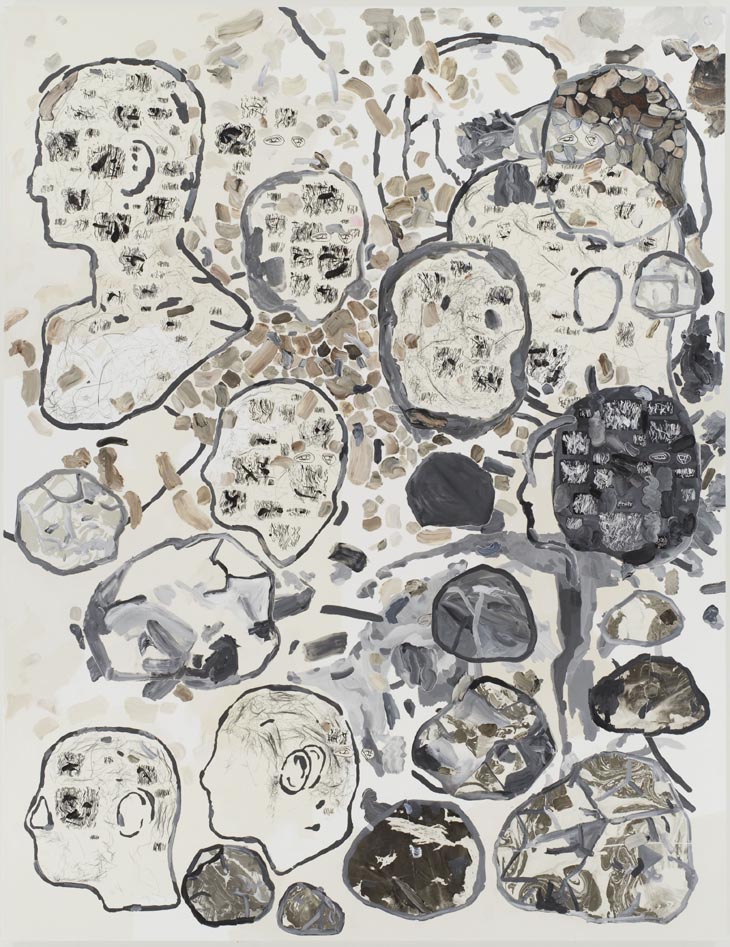
Carter
Carter’s Polaroids pose as casual snapshots, a series of ‘accidental’ photographs missing their target subject to capture only a pair of disembodied hands, a hint of human presence amidst various arrangements of inanimate objects. The appendages in the images are in fact fakes, plastic substitutions that render the notion of body as generic and interchangeable. In his exploration of the post-human, Carter searches for an idealised self: physiognomy, irrespective of difference, is explored as the equalising factor of human experience.
In Polaroid (2006 #1 and #2) and Polaroid (2006 #3 & #4) Carter pairs his photographs in diptych format. Each frame portrays the mannequin/artist in his studio, with subtle alterations in position and background: the potted plant moved a few inches, the drapery over the shrouded bust rearranged, a picture of a head included, then removed. Each of these elements becomes synonymous with the body itself, the differences in the photographs serve only to reinforce their sameness.
In Polariod (2006 #5) and Polaroid (2006 #6) Carter’s artificial hands are accompanied by the accoutrements of the living: comb, glass of water, houseplant, each lending a plausible authenticity to the dummy limbs. Arranged on top of a sheet of paper bearing the vague marks of an initialised sketch, Carter’s photographed assemblages further confuse the relationship between sculpture, drawing, and illusion. Using documentary medium of photography, Carter readily supplants the assumption of reality with an artificial construction, highlighting the discrepancy between outward appearance and inner content.
Staged in his studio, Carter’s Polaroids set up elaborate scenes of ‘artist-as-artifice’. Picturing a plausible snapshot of the artist explaining his work, Untitled resonates an eerie unreal quality, setting sickly wax-like hands against a collage of landscape photographs. Juxtaposing the dummy limbs to a backdrop of idealised nature, Carter exposes the malleability of representation; the fake arms sweeping with creator’s domination over the black and white wilderness. Using the ‘truthful’ documentation of photography to verify the charade, Carter examines the illusion of physical appearance, and the apprehension surrounding both nature and the synthetic.
Reducing the body into fragmented pieces, Carter explores the notion of unfixed identity. Drawing reference from the current obsession with plastic surgery and physical enhancement, Carter’s drawings offer abstraction as a portraiture of choice. In Untitled, Carter outlines five head-like shapes as blank canvases for viewer projection, accompanied by finely penned swatches of textures, and ‘Identikit’ doodles of eyes offering an ‘off the shelf’ array of figurative selection. Treating physiognomy as an alterable ‘costume’ with the potential to both conceal and reflect persona, Carter’s work contains an engagement with several moral and social issues, including media portrayal of body image, sexual closeting, and ethical questions arising from new cosmetic procedures.
Carter uses abstracted drawing as a means of investigation into the shifting concepts of the human body and personal identity. In Untitled, Carter presents a diptych of two rivalling fields of blob-like specimens, each self-contained like Petri dishes nurturing biological mutation. Using his own features as a control for experimentation, Carter’s two panels show subtle variations of the same forms, his abject and non-descript shapes converge as a catalogue of physical possibilities: eyes, lips, noses, and hairstyles float as disembodied samples for facial alteration, while geometric patterns clinically emerge as cell structures, globular tissue, or rough landscapes ripe for cultivation.
Carter’s Untitled posits human identity as organic compound. Collaged onto a marble textured base, Carter combines animal-mineral-vegetable in pseudo-scientific experimentation. Within his silhouetted heads, suggestions of human features appear as Periodic Table-like elements. Abject doodles appear as delicately illustrated specimens of unidentifiable matter: hair, muscle, fibre, something best left unknown, precision labelled with the equally nondescript and creepy word ‘the’. Through his detached bodies, Carter’s work provokes the fragile concept of the personal, reflecting the horror of a biodegradable self.
Placing archetypical profiles on a marbleised background, Carter alludes to the classical ideal of human proportion. Presenting duplicate ‘busts’, his drawing operates as 2 dimensional sculpture, his perfect white forms providing a solid template for manufactured identity. Rendering eyes, noses, and ears as empty voids, Carter points to a generic quality of physicality. The samples of hair on the left are used to create a complete model on the right. The finished product, cracked, vieny, and smudged, suggests stone rather than flesh, an unformed appearance ready for moulding.
Carter’s work reflects a fascination and unease with the human body as a metaphor for an anxiety of persona, the body being an outward projection and defining image of self. Untitled is set quite literally on a blank canvas. Here Carter presents a profile in the making: his half-finished portraits are accompanied by sketchy forms at the bottom of the drawing, inviting viewer participation in completing the image. Through piecemeal assemblage, Carter attributes his figures with personality traits as well as physical features: through the subtle quality of line, tone, and placement his characters resolve as fluctuating and contradictory personalities.
Carter’s idiosyncratic process extends from his material preparation to the act of drawing itself. Never working from imagination, all of Carter’s images are developed from what he describes as “life” study: careful anatomical examination of mannequins, sculptures and photographs. Modelling his images on figurative ‘stand ins’, Carter goes to great lengths to establish their veritas: often directly tracing a form, and always presenting the body in true scale. Through this element of reality, Carter’s work shuns the notion of painting as illusion or representation. Rather his abstractions embrace a concept of self-sustainable identity, giving validation to copy and placebo.
Often evolving his drawings from three dimensional models, Carter’s sculpture 1949, Self Portrait of a Homosexual 1965, 1970 poses as a synthetic ‘original’ in his ongoing practice of artistic ‘cloning’. Overt in its sexual subject matter, the title of this work points to key eras in art history where gay politics began to be included (retrospectively) as part of critical discourse. Constructed primarily of plaster and clay, Carter’s busts retain the rough hewn texture of their malleable material. Though titled Self Portrait, Carter conceives his sculpture as amorphous and anonymous, illustrating a process of becoming that transcends gender and social convention.
Developed from sketch of a life sized dummy merged with the outline of his own body, Carter’s Untitled personalises his intrigue with art history and sexual politics. Exploring the relationship between the legacy of artistic identity and the queer closeting predominant in the mid-20th century, Carter presents the masculine body as generic symbol and signifier. Drawing influence from artists such as Robert Rauschenberg, Jasper Johns, and Andy Warhol, Carter adapts various elements of their work, such as the relationship between drawing and sculpture, ironic reference to indexical painting, and identity as capitalist bi-product. In removing the idea of the individual, Carter conceives the human form as a universal prognostic of equality and choice.
Picturing the vague suggestion of a human form, Carter’s Untitled dissembles into a fragmented array of corporeal mark making. Through Carter’s trademark monochrome palette, he encapsulates references to both classical anatomical drawing and the infinite reproduction of photocopy and print media, translating the body into a system of coded information. Dehumanised and abstracted, Carter’s organic patterning suggests a strange intimacy, its subhuman formulations rendered sympathetic through personal gesture.
Though Carter’s drawings are directed by an intuitive aesthetic, they evolve from an incredibly time consuming and considered process. Carter begins each work by making his own marbleised paper. Referencing the emotive brushwork of Abstract Expressionist painting, Carter’s swirling patters are created through a ‘hands off’ procedure of dipping individual sheets into a water and oil solution – a process similar to developing photographs. Using these designs as a template over which multiple drawings are arranged and pasted, Carter merges repetitive forms with his ‘instantaneous’ colour-fields, creating a conceptual symbiosis between the intimacy of abstraction and the mechanisation of pop.
Carter’s Untitled directly confronts the unease with the corporeal. Highlighting the imperfection of physical matter, Carter renders his drawings in a clumsy manner, allowing delicate quality of ink to bleed with natural defections, and sometimes fixing the pen in an artificial hand in place of his own. Mapped out as a rough diagram, encircled patterns appear as microscopic organisms; alien and virus-like, they are conjoined by varicose lines, linking them to more recognisable features of hair, heads, and eyes. In the top left corner, Carter inserts an archetypical illustration of a hand, drawing attention to the anxiety of experiencing ‘the human’ or ‘self’ as a product of bio-mechanics.
Often substituting mannequin’s hands for his own – as models in his photos and videos, as well as an intervening tool in making his drawings – Carter personalises the prosthetic as an extension of self. In Untitled, Carter presents a photo examining both his own identity and public response to the constructed and altered body. Showing the hands of the artist at work, the plastic appendages are foreign and dead, conceiving the body as separate from mind. The photographed drawing in progress is begun in a highly controlled manner, and descends into crude gestures indicating the infiltration of an impostor, creating an estranged self-portrait of questionable origin.
Reducing the body into fragmented pieces, Carter explores the notion of unfixed identity. Making reference to the current obsession with plastic surgery and physical enhancement, Carter’s drawings offer abstraction as portraiture of choice. In Untitled (with Abstract Paintings) 2007 #5, Carter outlines a grouping of head-like shapes as blank canvases for viewer projection, accompanied by finely penned swatches of textures, painterly daubs of fleshy ‘skins’ and ‘Identikit’ doodles of eyes offering an ‘off the shelf’ array of figurative selection. Treating physiognomy as an alterable ‘costume’ with the potential to both conceal and reflect persona, Carter’s work contains an engagement with several moral and social issues, including media portrayal of body image, sexual closeting, and ethical questions arising from new cosmetic procedures.
